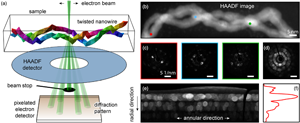Article contents
Analysis of Interpretable Data Representations for 4D-STEM Using Unsupervised Learning
Published online by Cambridge University Press: 08 September 2022
Abstract

Understanding the structure of materials is crucial for engineering devices and materials with enhanced performance. Four-dimensional scanning transmission electron microscopy (4D-STEM) is capable of mapping nanometer-scale local crystallographic structure over micron-scale field of views. However, 4D-STEM datasets can contain tens of thousands of images from a wide variety of material structures, making it difficult to automate detection and classification of structures. Traditional automated analysis pipelines for 4D-STEM focus on supervised approaches, which require prior knowledge of the material structure and cannot describe anomalous or deviant structures. In this article, a pipeline for engineering 4D-STEM feature representations for unsupervised clustering using non-negative matrix factorization (NMF) is introduced. Each feature is evaluated using NMF and results are presented for both simulated and experimental data. It is shown that some data representations more reliably identify overlapping grains. Additionally, real space refinement is applied to identify spatially distinct sample regions, allowing for size and shape analysis to be performed. This work lays the foundation for improved analysis of nanoscale structural features in materials that deviate from expected crystallographic arrangement using 4D-STEM.
- Type
- Software and Instrumentation
- Information
- Copyright
- Copyright © The Author(s), 2022. Published by Cambridge University Press on behalf of the Microscopy Society of America
References
- 10
- Cited by



